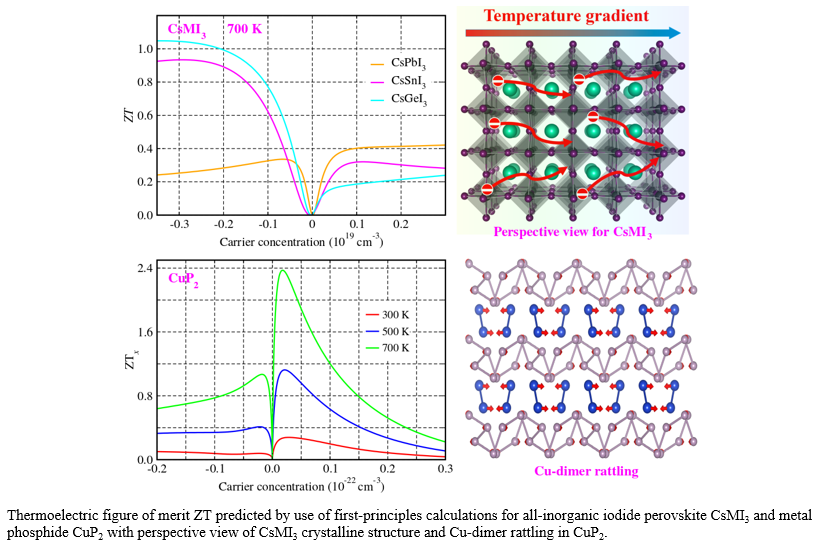Video Article Open Access
Advanced Thermoelectric Materials with High Performance and Low Cost: Ab Initio Study
Un-Gi Jong1,2*, Song-Nam Hong1, Yun-Hyok Kye1,2
1Computational Materials Design, Faculty of Materials Science, Kim Il Sung University, Pyongyang, PO Box 76, Democratic People’s Republic of Korea
2Natural Science Centre, Kim Il Sung University, Pyongyang, PO Box 76, Democratic People’s Republic of Korea
Vid. Proc. Adv. Mater., Volume 3, Article ID 2208343 (2022)
DOI: 10.5185/vpoam.2022.08343
Publication Date (Web): 28 Dec 2022
Copyright © IAAM
Graphical Abstract

Abstract
Conventional thermoelectric materials such as chalcogenides and Bi–Te alloying systems exhibit high thermoelectric conversion efficiency, but unfortunately, they include expensive rare-earth element Te thus hindering their application for large-scale power generation by using them. Searching novel thermoelectric materials with high performance and low cost is now receiving special attention and great challenges in the field of material design. To do this, we perform first-principles lattice dynamics combined with temperature-induced anharmonic phonon renormalization and connected to the Boltzmann transport equation in all-inorganic iodide perovskites CsMI3 (M = Pb, Sn, and Ge) and metal phosphide CuP2. First, we predict thermoelectric performance in the cubic CsMI3 at a high temperature of 700 K. Under stabilization of the cubic phase that exhibits strong anharmonic phonon modes at 0 K, our calculations show that at T = 700 K, these perovskites have ultralow lattice thermal conductivities below 0.6 W m−1 K−1 and high thermopower factors over 1.5 mW m−1 K−2, being comparable or superior to those of GeTe. Moreover, we find that cubic CsGeI3 and CsSnI3 have higher thermoelectric figure of merit ZT over 0.95 upon n-type doping, being attributed to the strong lattice anharmonicity and flat-dispersive electronic bands with high degeneracy. Next we study the thermoelectric properties of metal phosphide CuP2 in the monoclinic phase. Our lattice dynamics calculations reveal that CuP2 exhibits Cu-dimer rattling modes, which strongly scatter the heat-carrying acoustic and low-lying optical phonons, resulting in an unusually low lattice thermal conductivity below 3.6 W m-1 K-1, being about a half of the conventional thermoelectrics GeTe. We predict Seebeck coefficients, the value of which at 300 K is in good accordance with the experiment, and power factors that are superior to the conventional thermoelectrics GeTe, possibly due to flat- and dispersive-band structures with high orbital degeneracy. Finally, we assess its thermoelectric performance by evaluating the figure of merit ZT, finding that upon p-type doping ZT can reach over 1.3 at a high temperature of 700 K by optimizing the hole concentration. To conclude, our results highlight the potential of using metal phosphide CuP2 and inorganic iodide perovskites CsMI3 as a promising material for thermoelectric applications with practical performance and low cost.
Keywords
Thermoelectric materials; inorganic halide perovskite; metal phosphide; lattice dynamics; transport properties
Acknowledgement
The work was supported as part of the basic research project “Design of Innovative Functional Materials for Energy and Environmental Application” (no. 2016-20) by the State Commission of Science and Technology, DPR Korea. Computations have been done on the HP Blade System C7000 (HP BL460c) that is owned by Faculty of Materials Science, Kim Il Sung University.
References
- U.G. Jong, Y.S. Kim, C.H. Ri, Y.H. Kye, C.J. Yu, The Journal of Physical Chemistry C, 2021, 125, 6013.
- U.G. Jong, C.J. Yu, Y.H. Kye, S.N. Hong, H.-G. Kim, Physical Review Materials, 2020, 4, 075403.
- U.G. Jong, C.H. Ri, C.J. Pak, C.H. Kim, S. Cottenier, C.J. Yu, New Journal of Chemistry, 2021, 45, 21569.
Biography
Un-Gi Jong is a senior researcher of Faculty of Materials Science, Kim Il Sung University. He has got his Ph.D. degree in materials science from Kim Il Sung University in 2019. His research interest includes a computational materials design of energy conversion materials such as light absorber of perovskite solar cells and thermoelectrics by applying first-principles method. In 2021, he was awarded the Complimentary Membership from the American Chemical Society and became a Guest Editor for the journals of Frontiers in Physics and Frontiers in Energy Research.
Video Proceedings of Advanced Materials

Upcoming Congress



